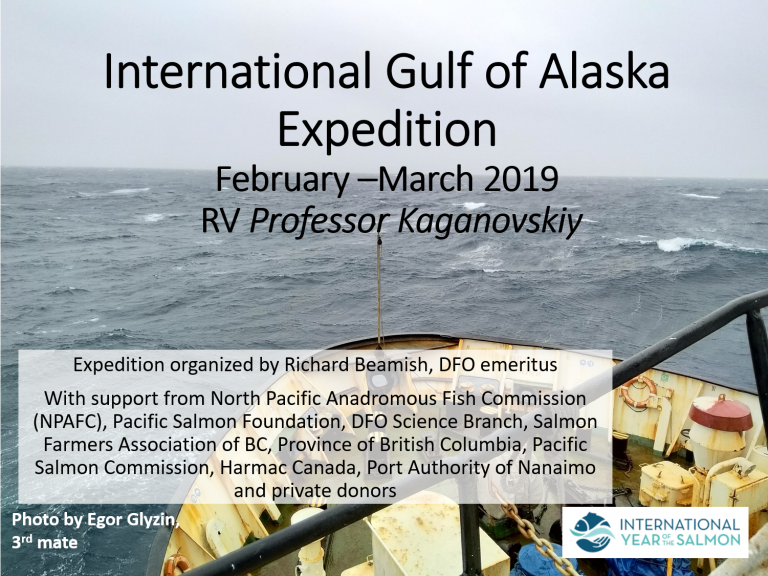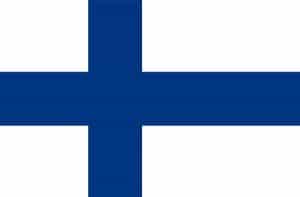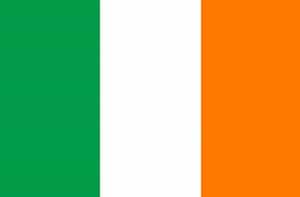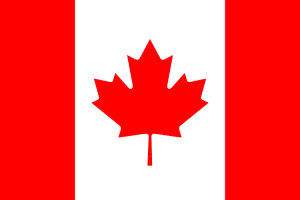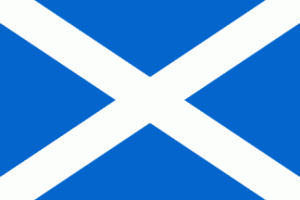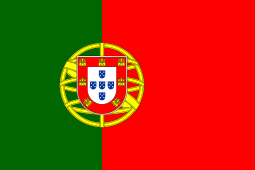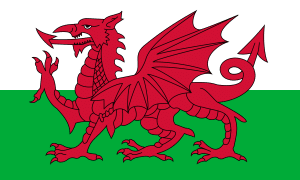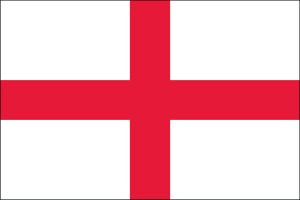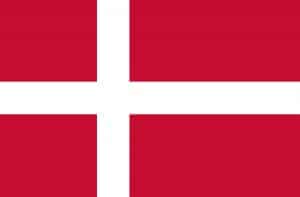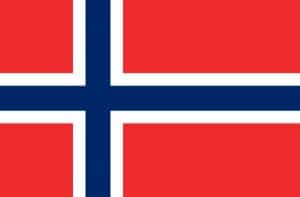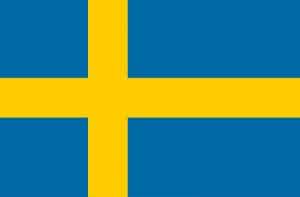International Gulf of Alaska Expedition
A bold winter expedition to study salmon on the high seas of the North Pacific Ocean
Overview
The scientific community believes that 1/3 of all Pacific salmon spend the winter in the Gulf of Alaska. Pacific salmon from Canada, Japan, Korea, Russia, and the United States are believed to mix together in the Gulf of Alaska. Impacts to salmon here, can impact salmon around the Pacific Rim. Returns from salmon rearing in this area have been highly variable.
The mechanisms behind these declines and booms remain to be determined. There have been limited surveys of the Gulf of Alaska. We simply do not know what mechanisms are operating and how the rapidly changing ocean ecosystems will affect these mechanisms. The major objectives of the Gulf of Alaska Expedition are to use DNA to identify the stock specific rearing areas for all five species of salmon and to determine their abundances and condition. This is the first time that this information will be available and it will be shared with the general public.
The expedition team consisted of 21 researchers from all Pacific salmon producing countries and a highly experienced crew. Surveys of abundance and condition of salmon in their first winter-at-sea are a logical extension of the early marine survival studies conducted in many nearshore marine areas. This expedition was focused on discovering the mechanisms regulating production through international collaboration.
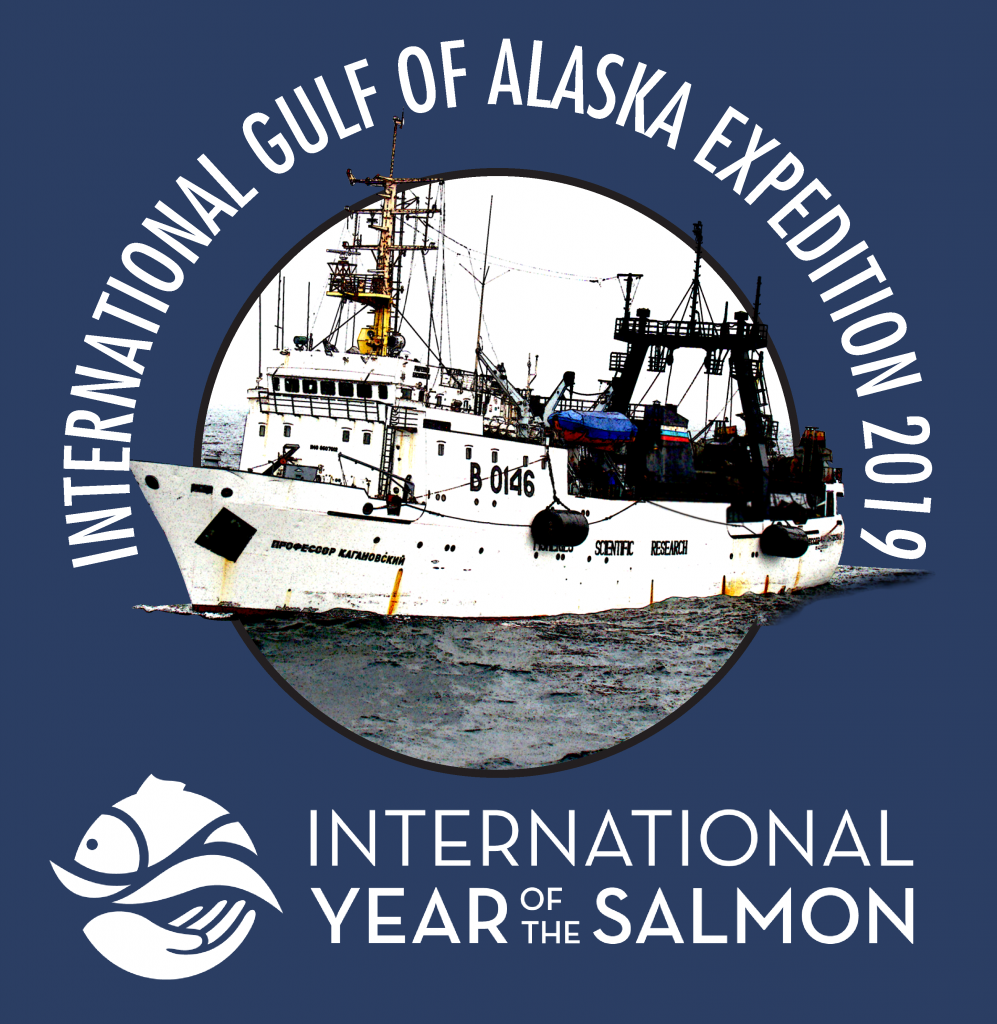
2019 International Gulf of Alaska Expedition Cruise Report
What did they find?
Expedition Details
Driven by the vision that a high seas winter survey of salmon in an International Year of the Salmon could be a transformative vehicle to galvanize five countries around a pulse of effort to understand the mechanisms driving the production of salmon, Dr. Dick Beamish has led a campaign to make it a reality. Dr. Beamish an emeritus scientist originally with Fisheries and Oceans Canada and Dr. Brian Riddell, the Executive Director of the Pacific Salmon Foundation led the funding drive that raised $1.2M to charter the Russian Vessel the Professor Kaganovsky. Donors included private individuals, NGO’s, Provincial and Federal governments.
The expedition is a Signature Project of the International Year of the Salmon (IYS) that also became a reality. The IYS is 5-year initiative to establish the conditions for resilience for salmon and people. The hemispheric partnership is being led by the North Pacific Anadromous Fish Commission, the North Atlantic Salmon Conservation Organization (NASCO) and a number of NGO’s, private sector, government and academic organizations.
The objective for the cruise includes as you would expect a number of scientific objectives. Interestingly a number objectives relate to people and culture. Learning how to merge scientific cultures and practices from five countries is not trivial. Over the years Russian, Canadian, American, and Japanese scientists have exchanged fishery scientists and run joint programs where several ships surveyed their respective zones using common methods but this is the first time they have all run a common program from a single ship. Learning how to collect and share data is a project itself. Russian scientists in particular have a 30-year history of studying salmon and the associated ecosystem. This is a tremendous opportunity to work directly with them to learn from them first hand.
The major scientific objective is to ultimately discover the fundamental mechanisms that regulate salmon in the North Pacific Ocean. The Expedition will be the first comprehensive study of the stock abundance, composition and condition of all stocks of all species of Pacific salmon at the end of their first ocean winter.
We expect to identify the stock specific rearing areas for all five species of salmon, their abundances and their condition. This information will be used to test the hypothesis that the fish that survive to the end of the first ocean winter are the individuals that grew faster in the first few months in the ocean.
What we learn on the expedition will inform the development of a proposed 5 vessel survey in 2021 that will span the entire North Pacific Ocean.
Departure from Vladivostok – January 11, 2019
Survey of the Western Pacific Ocean – January 11 to 30, 2019
Transit from survey area to Vancouver – January 30 to February 16, 2019
Arriving to Vancouver for loading scientific group and equipment – February 16, 2019
Departure from Vancouver – February 17, 2019
Return to Vancouver, BC (Canada), events to celebrate the cruise program completion – March 18, 2019
Courtesy visit to Pacific Biological Station, Nanaimo, BC – March 19, 2019
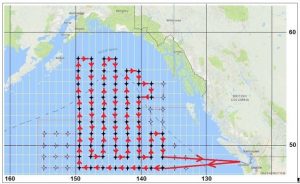
The Russian research vessel the Professor Kaganovskiy will transit from Vladivostok to Vancouver where it will pick up its full complement of 21 scientists. It will have conducted some research in the western North Pacific en route which will provide valuable data to compare with the Gulf of Alaska. This research, carried out by Russian scientists on board will provide abundance estimates for Pacific salmon. When our scientific team joined the vessel in Vancouver, they brought with them equipment which will allow on-board genetic analysis to be carried out. For the first time, we will be able to determine the specific high seas abundance of different stocks.
The expedition will leave Vancouver, BC, Canada on February 16 and will follow the track outlined in red. A grid of 72 stations approximately 60 nautical miles apart will be occupied in the Gulf of Alaska. Some of the stations were studied in the 1960’s and 1970’s by Japanese and Canadian researchers.
At each station a dizzying array of gear will be used to study the oceanography and the animals, including salmon in the upper 50m. A midwater trawl with a mouth opening of 50m will collect fish and invertebrates from an hour-long tow. The animals caught will be identified and samples. In addition to typical observations like the length and sex of the fish, samples will be taken to learn things like how old the fish is, what freshwater stock does is belong to, what was it eating, what pathogens is it carrying and how healthy physiologically is the fish. Geneticists will be testing a new handheld genetic sequencer that will potentially allow stock identification at sea for the first time. A live tank will be tested in the trawl to catch fish undamaged that will be tagged with satellite tags that when returned will tell researchers where the fish has been since it was tagged. How salmon navigate is still a mystery and these tags will help test the idea that they follow the earths magnetic lines.
At each station probes will be sent down 1,000m to measure how temperature, salinity, pH change with depth and plankton nets will be used to sample the food for salmon in the form of primary producers like algae and secondary producers like krill that feed on the algae and are feed on in turn by salmon. All of the salmon will be frozen and brought back for further study.
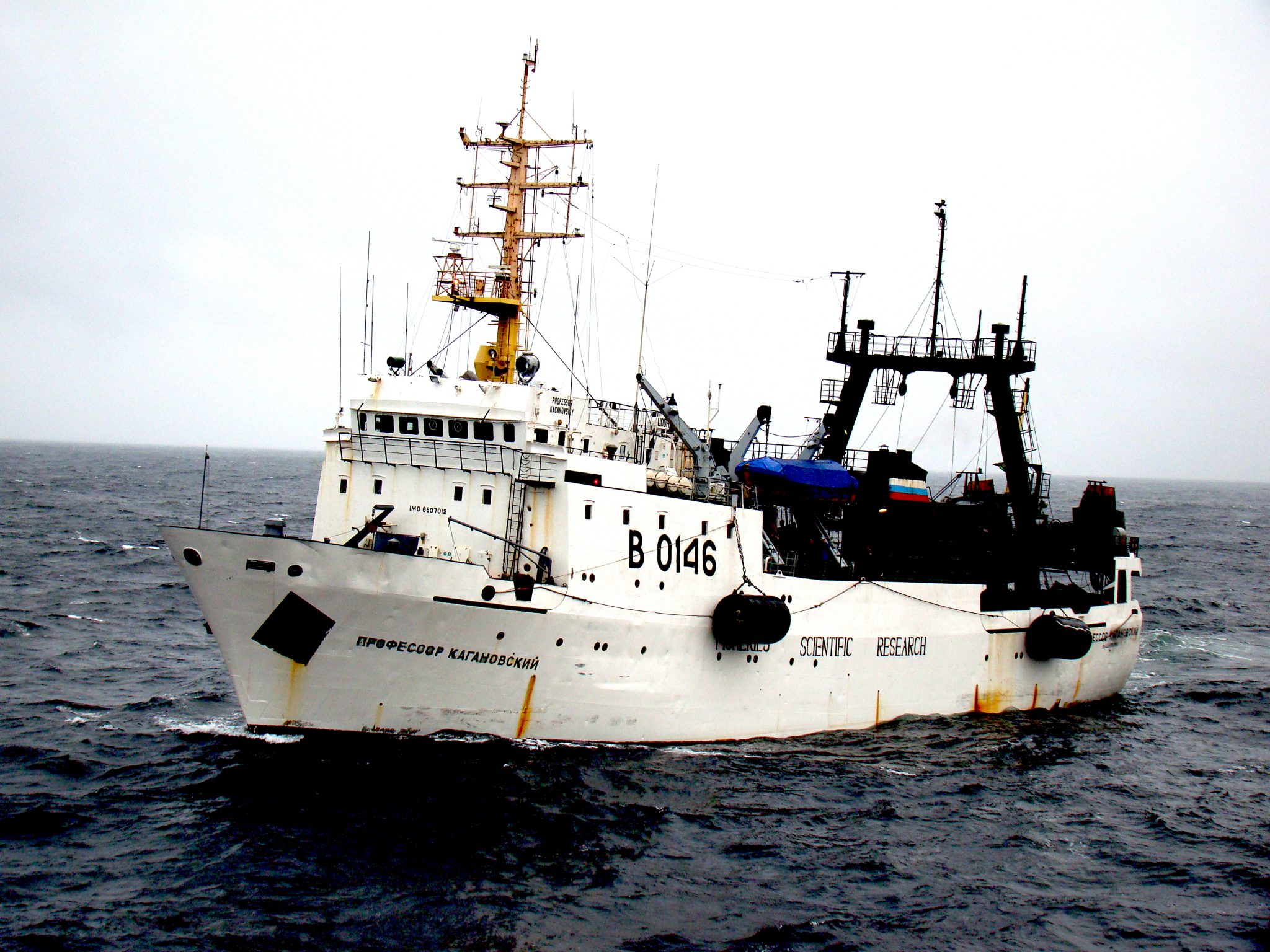
Name: Professor Kaganovskiy
Gross Tonnage: 2,062
Length Overall x Beam: 62.22m × 13.8m
Draught: 6.2m
Maximum Speed: 10.5 knots
Year Built: 1987
Home Port: Vladivostok
Flag: Russia
The Scientific Team
Meet the fascinating team of research scientists that will collaborate on this ground-breaking high seas salmon expedition that for the first time ever will include researchers from all five NPAFC Pacific Rim countries!!
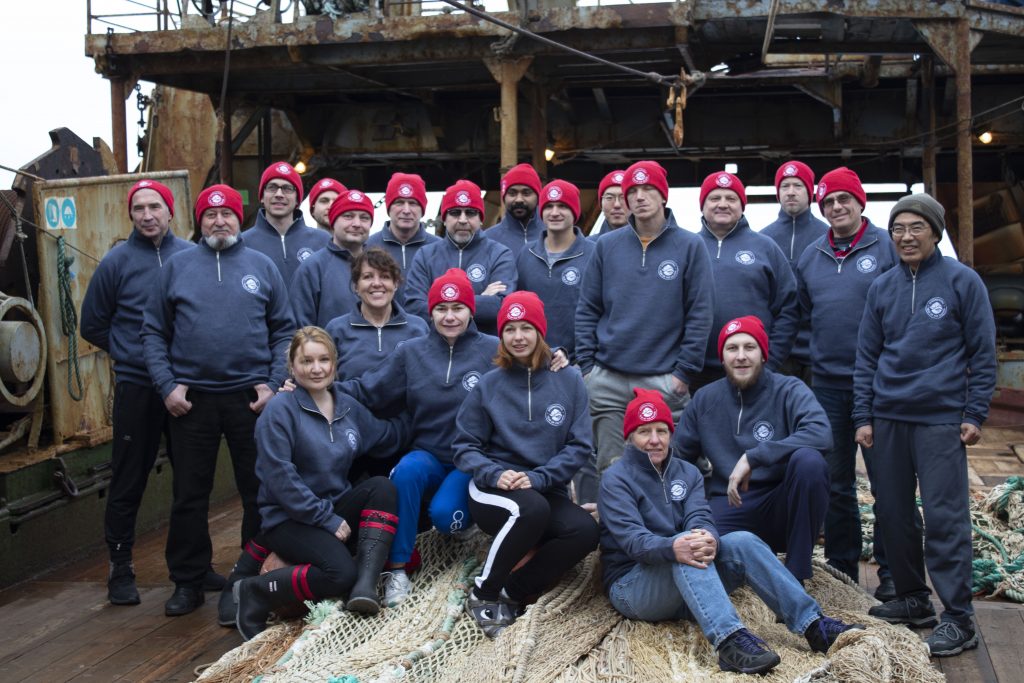
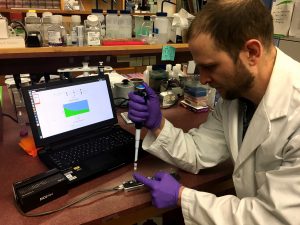 Christoph Deeg is first and foremost a biologist, with a background reflecting a broad interest in all “living” things. He started his research career in Germany and made contributions to a diverse number of fields including genetics and genomics of microorganisms and animals, fisheries research in the North Atlantic and North Sea, immunology of the innate immune system, conservation biology of salmon stocks and habitat on the central British Columbia coast, virology on the interactions of influenza with the innate immune system, and environmental microbiology. His PhD research at the University of British Columbia explored parasitic interactions in aquatic microorganisms, from giant viruses to predatory bacteria that form the base of the food web. Being a passionate outdoor enthusiast, he was able to take several field trips around British Columbia as well as the Caribbean to collect samples. After graduating, he decided to apply his broad skillset in organismal, molecular, and computational approaches with his passion for fieldwork to the management and conservation of Pacific salmon, a topic that he felt strongly about since moving to British Columbia. Christoph considers that having the opportunity to kick-start work in this field by joining the International Year of the Salmon Signature Expedition to the Gulf of Alaska alongside global leaders in salmon research is both a huge opportunity and an honour, and one that he is very much looking forward too!
Christoph Deeg is first and foremost a biologist, with a background reflecting a broad interest in all “living” things. He started his research career in Germany and made contributions to a diverse number of fields including genetics and genomics of microorganisms and animals, fisheries research in the North Atlantic and North Sea, immunology of the innate immune system, conservation biology of salmon stocks and habitat on the central British Columbia coast, virology on the interactions of influenza with the innate immune system, and environmental microbiology. His PhD research at the University of British Columbia explored parasitic interactions in aquatic microorganisms, from giant viruses to predatory bacteria that form the base of the food web. Being a passionate outdoor enthusiast, he was able to take several field trips around British Columbia as well as the Caribbean to collect samples. After graduating, he decided to apply his broad skillset in organismal, molecular, and computational approaches with his passion for fieldwork to the management and conservation of Pacific salmon, a topic that he felt strongly about since moving to British Columbia. Christoph considers that having the opportunity to kick-start work in this field by joining the International Year of the Salmon Signature Expedition to the Gulf of Alaska alongside global leaders in salmon research is both a huge opportunity and an honour, and one that he is very much looking forward too!
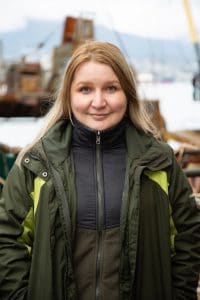 Svetlana Esenkulova is a biological oceanographer studying plankton and how it affects Pacific salmon. She has worked on projects at the Pacific Biological Station and with the Pacific Salmon Foundation associated with a five year study of Pacific salmon in the Strait of Georgia and Puget Sound. Svetlana has a number of interests and will be helping Chrys Neville with the sampling of salmon and the communications for the expedition. She will be collecting an “Expedition DNA sample” that will be used to ensure that there is a standard DNA sample for all salmon. She will also help to provide a focus on squid. Squid is an important component of salmon diet and it is especially important to Pacific salmon in the Gulf of Alaska. There are studies that indicate a relationship between the carrying capacity of the Gulf of Alaska for salmon species and squid abundance. However, despite its importance, very little is known about squid in the Gulf of Alaska. She hopes that results will offer new information on squid biology and ecology. Svetlana is excited to be part of a study that will for the first time study the abundance, distribution, and health status of salmon in the winter period in the Gulf of Alaska. She says that it is pretty cool when the genetic analysis will tell us what country and even what river each fish came from. When this is combined with an abundance estimate, there will be stock specific abundance estimates for the first time in the Gulf of Alaska. Svetlana looks forward to knowledge and experience exchange with researchers from five counties. She speaks English and Russian and is happy to help with communications. Svetlana believes that multicultural crews are more creative and hopes the team will be particularly effective due to the diversity and shared common goals. This survey is the first of its kind and from her personal point of view; results could be ground breaking. One of the practical results of this survey will be an improved assessment of salmon returns. And of course there will be new knowledge accrued that can advance salmon research in general and redefine how high seas studies are done. Svetlana is very honoured and grateful to be a part of what she considers to be an historic expedition.
Svetlana Esenkulova is a biological oceanographer studying plankton and how it affects Pacific salmon. She has worked on projects at the Pacific Biological Station and with the Pacific Salmon Foundation associated with a five year study of Pacific salmon in the Strait of Georgia and Puget Sound. Svetlana has a number of interests and will be helping Chrys Neville with the sampling of salmon and the communications for the expedition. She will be collecting an “Expedition DNA sample” that will be used to ensure that there is a standard DNA sample for all salmon. She will also help to provide a focus on squid. Squid is an important component of salmon diet and it is especially important to Pacific salmon in the Gulf of Alaska. There are studies that indicate a relationship between the carrying capacity of the Gulf of Alaska for salmon species and squid abundance. However, despite its importance, very little is known about squid in the Gulf of Alaska. She hopes that results will offer new information on squid biology and ecology. Svetlana is excited to be part of a study that will for the first time study the abundance, distribution, and health status of salmon in the winter period in the Gulf of Alaska. She says that it is pretty cool when the genetic analysis will tell us what country and even what river each fish came from. When this is combined with an abundance estimate, there will be stock specific abundance estimates for the first time in the Gulf of Alaska. Svetlana looks forward to knowledge and experience exchange with researchers from five counties. She speaks English and Russian and is happy to help with communications. Svetlana believes that multicultural crews are more creative and hopes the team will be particularly effective due to the diversity and shared common goals. This survey is the first of its kind and from her personal point of view; results could be ground breaking. One of the practical results of this survey will be an improved assessment of salmon returns. And of course there will be new knowledge accrued that can advance salmon research in general and redefine how high seas studies are done. Svetlana is very honoured and grateful to be a part of what she considers to be an historic expedition.
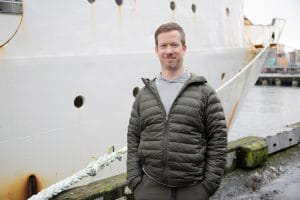 Gerard Foley views his participation in the International Gulf of Alaska Expedition as an exciting opportunity to be part of a rare sampling event in a body of water and time of year that is critical to salmon life history. He spent years working on the Bering Sea, completed a Master’s Degree at a foreign university and has participated in various marine ecology studies. Currently, Gerard is NOAA’s resident Biological Technician at the research hatchery Little Port Walter, Baranof Island, Alaska. Here they raise two stocks of Chinook salmon whose health and progress while at sea are of specific interest. He hopes that with a better understanding of the fitness and niche overlap of competitive salmon species in the Gulf of Alaska they will gain a better understanding of the factors affecting the returns to the hatchery at Port Walter.
Gerard Foley views his participation in the International Gulf of Alaska Expedition as an exciting opportunity to be part of a rare sampling event in a body of water and time of year that is critical to salmon life history. He spent years working on the Bering Sea, completed a Master’s Degree at a foreign university and has participated in various marine ecology studies. Currently, Gerard is NOAA’s resident Biological Technician at the research hatchery Little Port Walter, Baranof Island, Alaska. Here they raise two stocks of Chinook salmon whose health and progress while at sea are of specific interest. He hopes that with a better understanding of the fitness and niche overlap of competitive salmon species in the Gulf of Alaska they will gain a better understanding of the factors affecting the returns to the hatchery at Port Walter.
While the survey participants will address many key research questions, he and colleagues at NOAA are specifically interested in assessing the energetic status of salmon and estimating the overall carrying capacity of the Gulf of Alaska during this critical winter period. It is widely acknowledged that overwinter survival of salmon is influenced by summer growth rates and their ability to acquire sufficient lipid reserves prior to winter. Further, while interaction among salmon species and stocks occurs throughout their marine life history, winter is considered a period when competition for prey resources is highest. Additionally, recent high production of pink salmon (wild and hatchery-origin) in the North Pacific Ocean may be exerting top-down control on the food web that is impacting the growth and survival of other salmon species, as well as marine seabirds. Given the limited biomass of prey in winter and the potential for competition between salmon for this resource, he and Charlie Waters aim to determine if energetic status of salmon and carrying capacity in the North Pacific Ocean is compromised during winter. Their specific objectives are designed to address important questions regarding winter marine ecology of Pacific salmon in the Gulf of Alaska: (1) determine the hatchery component of pink, chum, and sockeye salmon during winter in the Gulf of Alaska, (2) develop indices of winter fitness for Pacific Salmon in the Gulf of Alaska, including energetic status and the degree of niche overlap between pink, chum, and sockeye and (3) test key indices in models for winter carrying capacity of Pacific salmon in the Gulf of Alaska.
Gerard and Charlie will achieve these objectives by collecting otoliths, dorsal muscle, liver, and gonad samples from immature sockeye, pink, and chum salmon captured from the survey. They will also collect zooplankton samples, including euphausiids and large and small copepods. These samples will be processed to determine energy density and lipid content, and a bioenergetics model for winter ecology of Pacific salmon will be constructed to understand winter fitness and carrying capacity.
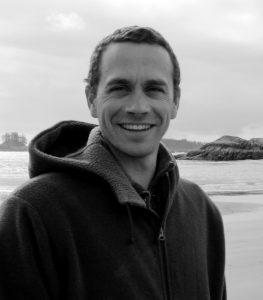
Brian Hunt is an Assistant Professor and Hakai Professor in Oceanography at the University of British Columbia’s Institute for the Oceans and Fisheries. Brian is a biological oceanographer by training with broad interests in the structure and function of pelagic marine ecosystems, and their response to climate forcing and anthropogenic impacts. He has participated in ten Antarctic research voyages, as well as voyages in the tropical and temperate South Pacific, Mediterranean, North Pacific and Arctic. Since moving to UBC in 2006, British Columbia coastal ecosystems have become a major research focus. After his initial involvement in the Tula Foundation funded Rivers Inlet Ecosystem Study between 2008 and 2011, Brian has worked extensively in partnership with the Tula Foundation’s Hakai Institute in developing Oceanographic Observatories in British Columbia, and conducting research into the early life history of juvenile salmon and herring. This work is done in collaboration with a growing network of Canadian researchers, including the Department of Fisheries and Oceans, First Nations, non-governmental organizations (NGOs) and other academic institutes. Brian uses a range of biogeochemical tools including stable isotopes and fatty acids for his research on food web dynamics which is a focal element of his research. Brian is currently using biogeochemical approaches to resolve salmon life history experience, specifically feeding ecology and habitat use, and their interactive effect on salmon health. During the Gulf of Alaska Expedition, Brian will be collecting samples for comprehensive biogeochemical analysis of salmon food webs in the Northeast Pacific, from plankton to the salmon. The resulting data will be used to parameterize salmon food web linkages, validate a recently developed North Pacific Isoscape model, and validate biogeochemical proxies of salmon feeding ecology and health that can be measured in fish on the spawning ground to reveal oceanic life history experience.
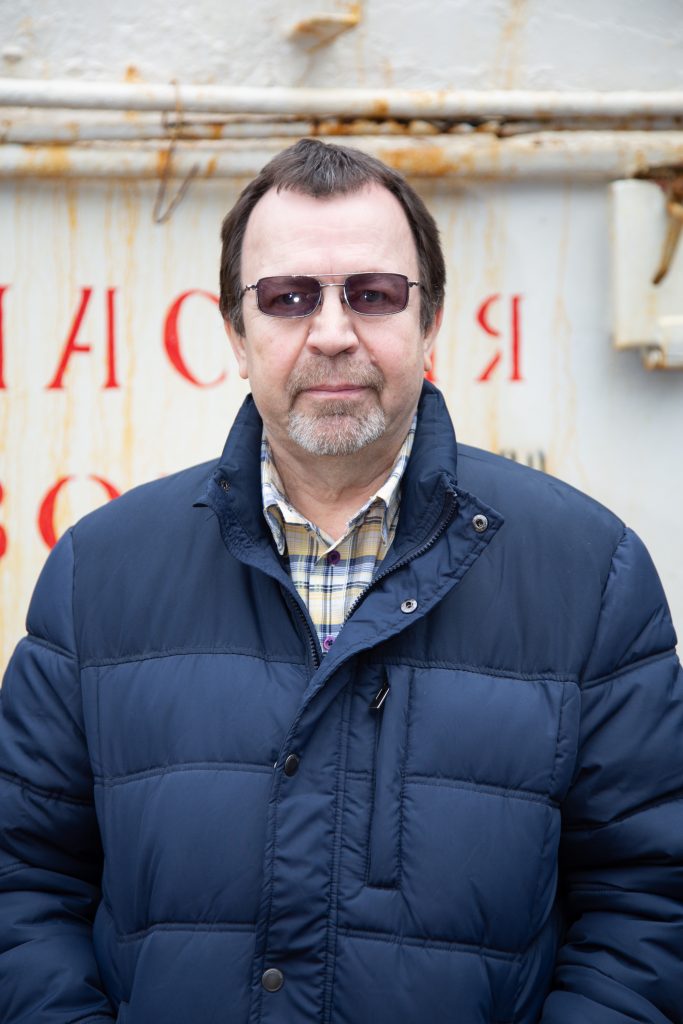 Arkadii Ivanov entered the Far Eastern State University at the Geophysical Section of the Department of Oceanology after graduating from high school in Irkutsk in 1975. In 1980, after graduating from university, he was assigned to the Pacific Scientific Research and Exploration Fleet Base (TURNIF), where he worked on research vessels and in an expeditionary flight crew until 1990. Later, he worked at FSU Rostech-DV ( the State Customs Committee), FSU “Pacific Directorate for Technical Support for Maritime Surveillance” (the Federal Service for Supervision of Use of Natural Resources), and in the hydrographic service of the Pacific Navy. Since 2018, he has worked in the laboratory of Fisheries Oceanography at the TINRO-Center in Vladivostok.
Arkadii Ivanov entered the Far Eastern State University at the Geophysical Section of the Department of Oceanology after graduating from high school in Irkutsk in 1975. In 1980, after graduating from university, he was assigned to the Pacific Scientific Research and Exploration Fleet Base (TURNIF), where he worked on research vessels and in an expeditionary flight crew until 1990. Later, he worked at FSU Rostech-DV ( the State Customs Committee), FSU “Pacific Directorate for Technical Support for Maritime Surveillance” (the Federal Service for Supervision of Use of Natural Resources), and in the hydrographic service of the Pacific Navy. Since 2018, he has worked in the laboratory of Fisheries Oceanography at the TINRO-Center in Vladivostok.

Hae Kun Jung is a Doctoral student in the Fisheries Oceanography Laboratory of Chung Il Lee in Gangneung-Wonju National University, Republic of Korea. He was part of the overwintering team at the King-Sejong Station in the Antarctic in 2015. He is interested in the interaction between fisheries resources around Korean waters and their environments across multiple life history stage. A major area of study is the effect of climate driven shifts in oceanic condition in the North West Pacific on changes in fisheries resources such as migration routes and distribution patterns. His interests in climate, oceanography and fishes make him a perfect member of the research team.
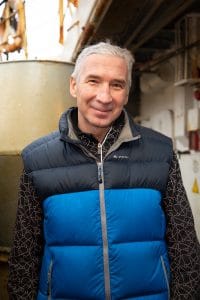
Gennady Kantakov began working as an oceanographer beginning in the 1980s when he completed a Bachelor of Science degree at the oceanology faculty in Saint Petersburg Hydromet University. He considered himself lucky enough to study all fields devoted to the oceanography such as, hydrography, hydromet, offshore, remote sensing, academician research and even fisheries science. All his studies were located in the Pacific Ocean and vicinities. As a curious person, during a scuba diving expedition to collect data regarding “Isoyake” phenomena (kelp denudation) near Sakhalin in 1994, he saw underwater a real “bullion of life” (juvenile fishes, invertebrates, medusae, zooplankton, marine snow from phyto, etc.) that he said “switched my brain to the biological oceanography field” where he completed scientific work in the Sea of Okhotsk and Sea of Japan. Later, in early 2000s he became involved in juvenile Pacific salmon research that included studies in the winter as well as efforts to develop an optical counter for the zooplankton. Eleven years ago he started a business providing ocean equipment deliveries to the Russian market but is still involved in science and continues to develop advanced methods for the routine oceanographic research. Gennady greatly appreciates the chance to participate in the winter salmon study in the Gulf of Alaska because it is “a magical chance for a curious person” and a unique professional opportunity. Getting a chance to measure ocean abiotic parameters such are temperature, salinity at the same time there is a comprehensive study of the biology and ecology of salmon in the open ocean will open the “black box time of their life”. He considers this “a rare moment of truth that will provide insights into questions such as how many salmon can be produced in the ocean”. Gennady says “imagine if somebody asked Armstrong many years ago if he was he willing to walk on the Moon”. Do you think you would await an answer? It’s yes! Definitely. Here is the same case for me, but only in another field.
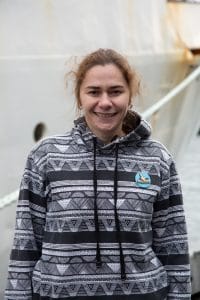
Albina Kanzsparova graduated from Perm University with a specialisation in ichthyology and then moved to the eastern part of Russia to study Pacific salmon. From 2005 to 2015, she worked as a research fellow in TINRO, Khabarovsk city branch where she studied the freshwater life of pink and chum salmon in the Amur River and rivers on the North Coast of Okhotsk Sea and the Shantar Islands region. The Amur River is three times the size of Columbia River and is comparable to Yukon River which is why her work experience obtained on Amur is so unique.
Historic Chum catches in 1910 were 93 metric ton. In 2016 it was 42 metric ton. It was part of her work to understand how fishing affects the production of chum salmon in the Amur River. Her work with the commercial salmon fisheries during spawning migration was tracking migration, biological analysis, and determining the catch per effort. After the spawning migration, she counted the spawned out salmon on foot and used all of the data collected to estimate the production of juveniles that would rear in the North East part of Okhotsk Sea.
Since 2016, Albina worked in TINRO in Vladivostok in the fish stocks forecasting branch. In 2016 she participated in the project “Wild and Hatchery Salmon” in Prince Williams Sound, Alaska where she gathered samples for DNA analysis and otoliths from pink salmon. “Working there was fun as we had a very friendly team” recalled Albina. Since 2017, Albina has participated in the annual TINRO trawl surveys which will be similar to the survey in the Gulf of Alaska. In summer, they estimate pink returns in the Pacific Ocean, close to Kuril Islands and Okhotsk Sea and in the fall – juvenile migration from Okhotsk Sea to Pacific. This is 24 hour work with a pelagic trawl, sorting of the catches and collecting samples. All of the information is used for catch forecasting of pink salmon in Okhotsk Sea basin. Albina sees her participation in the Gulf of Alaska expedition as a novel investigation phase in her career. She thinks that the Gulf of Alaska and Russian Far East are not separated by the Pacific Ocean but unified by the Pacific Ocean. Because of that, she wants to see how salmon stocks are formed in both sides of the ocean, what are the processes that define the stocks, what factors are common and what are region specific. Russia reached salmon catches of 0.5 mi metric ton in 21st Century. As a biologist, Albina would like to understand what factors lead to higher returns and what can be done to maintain this high salmon productivity of the ocean.
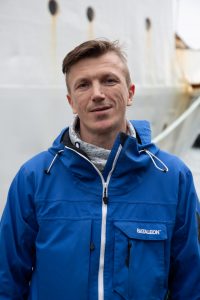 Anton Khleborodov graduated in hydrobiology from the Far East University in Vladivostok and has worked in TINRO in Vladivostok since 2011. Anton has extensive experience in field work where for about 5 years he studied decapod (Crustacea Decapoda) abundance in the Far East Russia. Anton is currently interested in the food that is eaten by a number of fish species but with a focus on salmon. Food relationships among species and an understanding of the dynamics of how this food is produced in the plankton are crucial to an understanding of biological capacity of marine ecosystems to produce salmon. One of the major activities in the expedition will be a study of the energy levels of salmon at the end of the winter. It is generally understood that food levels will be lowest in the winter and thus winter is a time that may most affect salmon survival. Understanding the amount of food that is available in the winter therefor is an important part of the expedition. Anton’s main goal is to estimate salmon food supplies, define plankton species composition in the Gulf of Alaska and to compare results with similar information from Russian waters. Anton is confident that the data he collects will be of interest for both Russian scientists and his Canadian colleagues.
Anton Khleborodov graduated in hydrobiology from the Far East University in Vladivostok and has worked in TINRO in Vladivostok since 2011. Anton has extensive experience in field work where for about 5 years he studied decapod (Crustacea Decapoda) abundance in the Far East Russia. Anton is currently interested in the food that is eaten by a number of fish species but with a focus on salmon. Food relationships among species and an understanding of the dynamics of how this food is produced in the plankton are crucial to an understanding of biological capacity of marine ecosystems to produce salmon. One of the major activities in the expedition will be a study of the energy levels of salmon at the end of the winter. It is generally understood that food levels will be lowest in the winter and thus winter is a time that may most affect salmon survival. Understanding the amount of food that is available in the winter therefor is an important part of the expedition. Anton’s main goal is to estimate salmon food supplies, define plankton species composition in the Gulf of Alaska and to compare results with similar information from Russian waters. Anton is confident that the data he collects will be of interest for both Russian scientists and his Canadian colleagues.
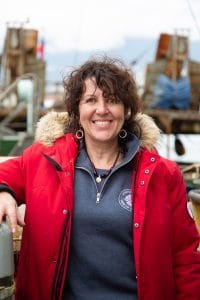
Chrys Neville is a research biologist and the Head of the Salmon Marine Interactions Program in the Regional Ecosystem Effects on Fish & Fisheries Section, Ecosystem Science Division at the Pacific Biological Station in Nanaimo. Chrys has over 25 experience leading field research programs studying the marine ecology of juvenile Pacific salmon. She has published and presented numerous papers on salmon ecology and the effects of climate on regional ecosystems and residency of juvenile salmon. Chrys became a biologist due to her love of the outdoors, nature and adventure. She joined the expedition for these reasons and the ability to learn something new about species that she has studied for many years. She comments that over the past 25 years there have been many changes and new approaches developed in fisheries research but the one thing that is unchanged is the necessity to actually go in the field and see first hand what is happening . “The changes that continuously occur between seasons, years or regions always amaze me and without being in the field and observing first hand, many of the subtle changes or shifts would be missed,” she says, “yet these changes may be the best clues to understanding the declines or shifts in salmon productivity”.
Over the past five years, the focus of her research has been on the factors regulating the early marine survival and distribution of juvenile Chinook, coho and sockeye salmon. Chrys did not hesitate to agree to be part of the expedition when invited. She immediately recognized the opportunity to relate the research she does in the Strait of Georgia to fish from the same populations that migrate into the Gulf of Alaska where they spend their first ocean winter. Of particular interest are sockeye salmon from the Fraser River. There are unexplained trends in the production of these sockeye salmon that could be related to their growth in the first months in the ocean. The expedition will allow this hypothesis to be tested. It is not known where Fraser River sockeye salmon rear in the Gulf, but it is suspected that the area is different than sockeye salmon originating from the west coast of Vancouver Island. Discovering the rearing area and estimating their abundance will be a major contribution. Chrys will also focus on Chinook salmon captured in the expedition, specifically examining the energy density of various stocks captured across different regions and areas. In addition to the science, Chrys will be head of communications for the expedition. She plans daily reports and interviews that will go directly to media and will be featured in a major Vancouver newspaper. Chrys is excited to be working with researchers from many countries. Her passion outside of science is travel and getting to meet people and experience places from around the world. “I never expected my next trip to be to the middle of the Northeast Pacific in the middle of winter,” Chrys states, “however, I always say that I want to explore the world and this is definitely an area that only science could take me!”
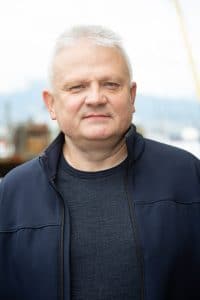
Evgeny Pakhomov is a Professor in the Department of Earth, Ocean and Atmospheric Sciences and a Director of the Institute for the Oceans and Fisheries at the University of British Columbia. A graduate of the Russian Academy of Sciences, he has more than 30 years of research experience as a biological oceanographer. His research focuses on understanding physical-biological interactions and ecosystem response to climate change or global warming, from the Antarctic to coastal British Columbia and from coastal realms to high seas. His research interests span species ecology (from plankton to fish), ecosystem structure and function, and biochemical coupling. Prof. Pakhomov has disseminated his work in more than 200 publications. He is a recipient of the Vice-Chancellor’s Distinguished Research Award, Rhodes University, South Africa; the Alexander von Humboldt Foundation Research Award, Germany; the New Opportunities Fund Award from the Canadian Fund for Innovation; and the Senior Early Career Fellowship from the Peter Wall Institute for Advanced Studies at the University of British Columbia. He has strong links to several laboratories and institutions worldwide, including the Alfred Wegener Institute for Polar and Marine Research in Germany, the British Antarctic Survey, NIWA in New Zealand, the University of Hawaii, and Rhodes University, South Africa.
As a biological oceanographer, Evgeny is most interested in zooplankton (creatures from 0.2 to 2 cm in size) and micronekton (creatures from 2 to 20 cm in size). Both of those play critical roles in the pelagic ecosystems because they link primary producers (mainly microscopic plants) with larger fish, including salmon. So, one could say that he is very interested to study what and how much food salmon consume. For most of his career, Evgeny worked in the Southern Ocean uncovering questions related to how the pelagic ecosystems are structured and work. His interest in the North Pacific related to the pelagic ecosystem functioning. This is very relevant because Pacific salmon spend several years in the open ocean, where they grow rapidly and accumulate reserves to be able reproduce successfully, yet we know little about this ecosystem. We do not know how many salmon can be accommodated there, which is key to understanding how many fish can be added through hatcheries. We also would like to understand how robust or resilient the North Pacific ecosystem is to climate change, which is relevant in predicting salmon population long-term trends. Evgeny believes that this voyage is an incredible and unique opportunity to study salmon and their supporting pelagic ecosystem. Because the area is so poorly studied in the winter, essentially most information collected by the expedition about the ecosystem and how it supports salmon will be novel.
Evgeny was asked to be a Chief Scientist because of his over 35 years of sea-going experience, including being a Chief Scientist on numerous occasions and because of his international reputation for the understanding and promotion of the ecosystem approach to the fisheries research. The fact that he also speaks English and Russian fluently will be advantageous onboard the Russian chartered ship. Dr. Pakhomov says that “I am at heart a sea- going, field scientist and I am anxious to be back at sea”.

Vladimir Radchenko is an internationally recognized fisheries scientist and an authority on pink salmon. Vladimir was born in Ukraine (USSR Republic) and educated at the Kharkov State University at the faculty of Biology. He started his career as a chief researcher at Pacific Research Fleet Base and then worked up through several scientific and managerial positions in fisheries research institutes in Vladivostok and Yuzhno-Sakhalinsk, Russian Federation. He took part in 19 scientific marine expeditions and led nine of them. His research interests include North Pacific marine ecosystems, Pacific salmon, conservation biology, and fisheries management. He has published extensively in scientific journals and is considered to be one of Russia’s top fisheries scientists. In 2010, he became the Deputy Head at the Science and Education Department in the Federal Agency on Fisheries in Moscow. He moved to Vancouver in June 2013 to become Executive Director of the North Pacific Anadromous Fish Commission (NPAFC).
His professional and personal interests in participation in the Gulf of Alaska survey are hard to separate. Vladimir will work to ensure the expedition success since, in his opinion, it is critically important for the progress of the science in NPAFC and the successful implementation of the International Year of the Salmon (IYS) which is the major NPAFC Scientific program. As a researcher, he is very interested in revealing how a quantitative distribution of Pacific salmon changes in a warming Pacific Ocean. This new knowledge will test his personal understandings about how global climate processes will affect marine ecosystems of the Northern Hemisphere.
Vladimir and the North Pacific Anadromous Fish Commission were key to being able to have a privately funded, international study of Pacific salmon in the winter in the Gulf of Alaska using a charted Russian research ship. Vladimir immediately agreed to the concept when asked by Dick Beamish several years ago and to be a chief scientist or equivalent, “even if I need to take holidays” he said. NPAFC was the essential link needed to transfer the funds that were being “banked” in the Pacific Salmon Foundation in Vancouver. NPAFC promotes the acquisition, analysis and dissemination of scientific information pertaining to anadromous stocks and ecologically related species in the North Pacific Ocean. Thus, the expedition provided an opportunity to focus on major factors impacting Pacific salmon survival in the high seas that can be a topic of debate within the NPAFC community. Vladimir recognizes that research cruises on specialized research vessels remain the most reliable, productive and history-making way to obtain new knowledge on composition, dynamics, and functioning of marine life, including Pacific salmon. He is confident that the research survey throughout the area of salmon wintering in the Gulf of Alaska will give answers to the major questions about salmon ecology and the regulation of salmon abundance.
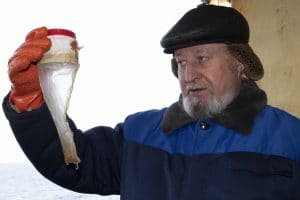
Alexander Slabinskii graduated from the Far Eastern State University (FESU) in 1976. In the same year, he entered the TINRO-Center at Vladivostok in the Hydrobiology Laboratory as a junior Research Assistant and then as a Research Assistant, where he continues working at present. He annually participates in the integrated surveys in the far-eastern seas where his research interests include studies of zooplankton of north-western Pacific Ocean, Bering and Chukchi Seas.
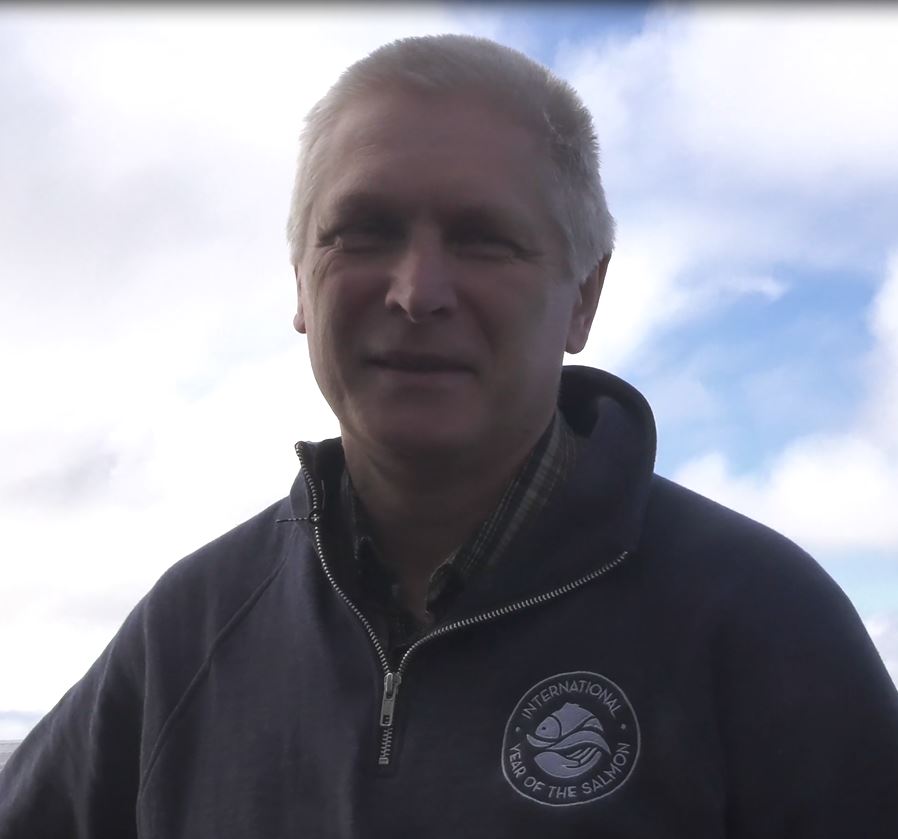 Igor Shurpa, graduated from Hydroacoustic and Ultrasound Engineering Department of the Far Eastern Polytechnic Institute in 1985 with a graduate degree. Since that time he annually participates in several marine expeditions. He worked in the Pacific Scientific Research and Exploration Fleet Base (TURNIF) from 1985 to 1996, in the Scientific Fleet Base (BIF) of the TINRO-Center from 2002 to 2016, and in the FSBSE TINRO-Center from 2016 to the present where he is an engineer of scientific equipment
Igor Shurpa, graduated from Hydroacoustic and Ultrasound Engineering Department of the Far Eastern Polytechnic Institute in 1985 with a graduate degree. Since that time he annually participates in several marine expeditions. He worked in the Pacific Scientific Research and Exploration Fleet Base (TURNIF) from 1985 to 1996, in the Scientific Fleet Base (BIF) of the TINRO-Center from 2002 to 2016, and in the FSBSE TINRO-Center from 2016 to the present where he is an engineer of scientific equipment
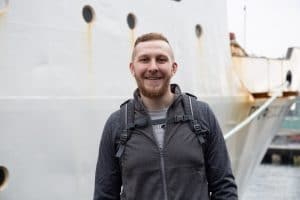
Aleksei Somov, is an ecologist, studying pelagic communities at TINRO, in Vladivostok. He finished a postgraduate degree last year and is currently working on a Candidate Dissertation. The topic of his research is nekton composition, structure, and dynamics in epipelagic region of the East Bering Sea. The fish stocks found in Eastern region of the Bering Sea have significant importance to Russian commercial fisheries. This region is a major feeding area for commercially important species including walleye pollock, herring, halibut, Pacific cod and of course, salmon. In the open waters, in the summer-fall period, there are substantial numbers of salmon feeding prior to their spawning migration. Aleksei’s goal is to find seasonal, annual and spatial patterns of epipelagic communities and connect the patterns to climate and oceanographic changes on the regional and on the global scale. To reach this goal he expects to analyze vast amounts of data collected during annual TINRO surveys since 2000 and available climatic data, including satellite images. Because the study region is not an enclosed water body, all processes and changes in communities depend a lot on what is going on in adjacent areas. This is especially relevant for Pacific salmon, as local and non-local stocks in Russian waters of Bering Sea migrate south from Aleutian Islands to Gulf of Alaska for winter period and then migrate again to west part of the Bering Sea to spawn. The question about how critical the winter period is for salmon survival remains to be answered. This complex expedition in the Gulf of Alaska will become a big step in answering this question. As a young scientist Aleksei is very interested in sharing and learning field methods and expertise with international colleagues. Participating in this expedition is a wonderful opportunity to work shoulder to shoulder with colleagues from Canada, USA, Japan, and Korea on solving this important question.
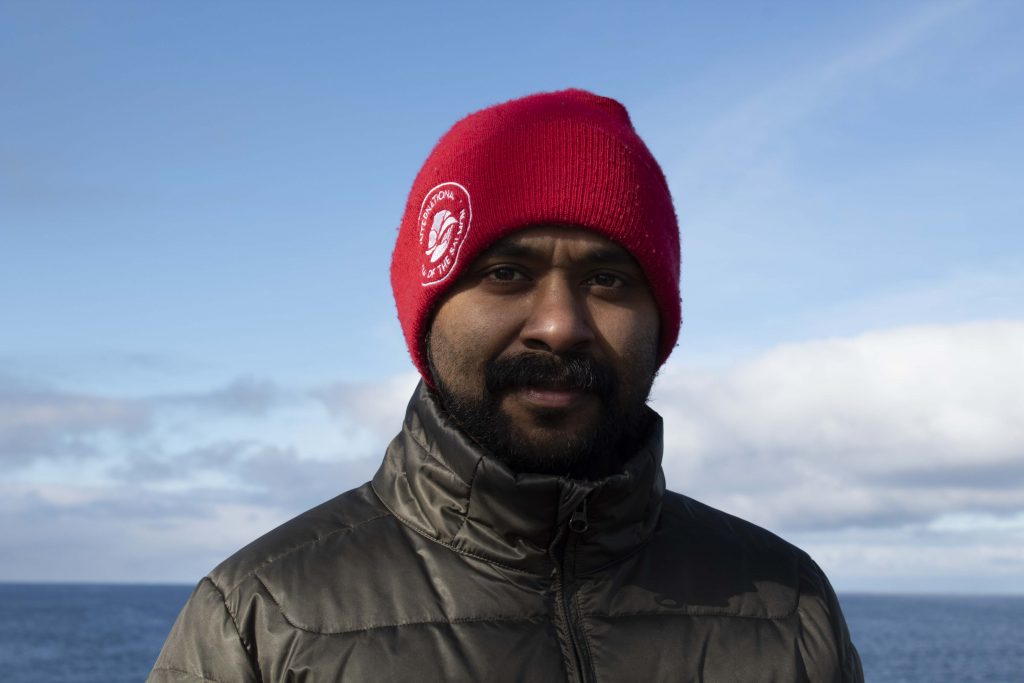 P.S. Vishnu is a PhD student at the University of Victoria, Department of Geography. Vishnu’s interests are in Physics and Environmental Sciences, focusing on ocean optics and remote sensing. His research focuses on developing novel satellite remote sensing techniques to identify and optically characterize dominant phytoplankton groups. The recent development in optical remote sensing has led to the advent of hyperspectral sensors, which can measure spectral reflectance of seawater continuously over the entire visible spectrum with narrow bands. He is using this technology and satelite-based ocean colour imagery to advance an understanding of the spatial-temporal ocean productivity in the migration route of salmon along the coastal areas of British Columbia and South East Alaska. These studies are limited to coastal waters, diminishing the ability to understand the oceanographic conditions experienced by salmon along their entire migration route. The Gulf of Alaska Expedition will allow Vishnu and his supervisor, Dr. Maycira Costa, to acquire data in areas never sampled, which in turn will enhance their ability to better use satellite imagery for the region. Importantly, the collaborative nature of the Expedition will integrate data provided by satellites over large areas with in situ data on ocean biogeochemistry, genetic, zooplankton and fish diet to better understand how climate and the changing ocean environment affect salmon production. As part of the Gulf of Alaska Expedition, his objective is to use satellite imagery to define the salmon habitat condition in the Gulf of Alaska. Specifically, he will use imagery from Sentinel-3 (300 m spatial resolution) and VIIRS and MODIS-Aqua (1 km resolution) to measure chlorophyll concentration and phytoplankton groups.
P.S. Vishnu is a PhD student at the University of Victoria, Department of Geography. Vishnu’s interests are in Physics and Environmental Sciences, focusing on ocean optics and remote sensing. His research focuses on developing novel satellite remote sensing techniques to identify and optically characterize dominant phytoplankton groups. The recent development in optical remote sensing has led to the advent of hyperspectral sensors, which can measure spectral reflectance of seawater continuously over the entire visible spectrum with narrow bands. He is using this technology and satelite-based ocean colour imagery to advance an understanding of the spatial-temporal ocean productivity in the migration route of salmon along the coastal areas of British Columbia and South East Alaska. These studies are limited to coastal waters, diminishing the ability to understand the oceanographic conditions experienced by salmon along their entire migration route. The Gulf of Alaska Expedition will allow Vishnu and his supervisor, Dr. Maycira Costa, to acquire data in areas never sampled, which in turn will enhance their ability to better use satellite imagery for the region. Importantly, the collaborative nature of the Expedition will integrate data provided by satellites over large areas with in situ data on ocean biogeochemistry, genetic, zooplankton and fish diet to better understand how climate and the changing ocean environment affect salmon production. As part of the Gulf of Alaska Expedition, his objective is to use satellite imagery to define the salmon habitat condition in the Gulf of Alaska. Specifically, he will use imagery from Sentinel-3 (300 m spatial resolution) and VIIRS and MODIS-Aqua (1 km resolution) to measure chlorophyll concentration and phytoplankton groups.
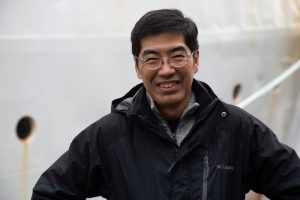
Shigehiko (Hiko) Urawa is one of Japan’s foremost fisheries scientists, renowned for his research on chum salmon. Currently he is a senior researcher at the Hokkaido National Research Institute, FRA. In addition to his research, Dr. Urawa has been actively involved with the North Pacific Anadromous Fish Commission for several decades, representing Japan on a number of committees and then being elected as Deputy Director in 2006 where he worked out of their office in Vancouver until he returned to Japan in November 2010 as Deputy Director, Salmon Resources Division, Hokkaido National Fisheries Research Institute, FRA. He participated in the first trans-Pacific cruise survey in the winter of 1996, and found that the Gulf of Alaska is an important winter habitat for Pacific salmon. He showed that not only North American chum populations but also Asian (Japanese and Russian) populations migrate a long way into in the Gulf of Alaska in winter. However, he notes that it still remains a mystery why most chum salmon populations assemble in the Gulf of Alaska only in winter. Dr. Urawa hopes to use the information from this expedition to determine the southern limit and annual variation in winter salmon distribution in the Gulf of Alaska. He thinks that the winter distribution of chum salmon may be different among regional populations and also among age groups, even within the relatively small areas in the Gulf of Alaska. The winter distribution pattern may reflect stock- or age-specific preferences for water temperature to maximize survival. This could mean that future climate warming may affect the distribution, trophic condition, and survival of salmon overwintering in the Gulf of Alaska. The response of salmon to climate-driven changes may be different among regional stocks, depending on their habitat locations. Dr. Urawa will be in charge of tagging salmon during the expedition. He brings a special net that will catch salmon and keep them in good condition while a special data logger tag is applied. He will also collect genetic and otolith samples that he will use to (1) determine the stock-specific winter distribution range and abundance of chum salmon in the Gulf of Alaska, (2) evaluate their stock-specific habitat features and responses to ocean environmental changes and (3) develop models that predict the future distribution and abundance of chum salmon.
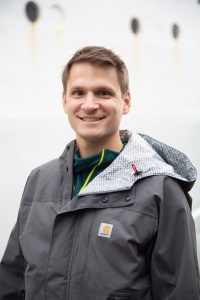
Charlie Waters’ graduate work focused on salmon conservation genomics and he is relatively new to conducting salmon marine ecology research as a Research Fish Biologist with NOAA’s Alaska Fisheries Science Center. He immediately jumped at the opportunity to participate in the Gulf of Alaska Expedition as an exciting way to enhance his knowledge of Pacific salmon marine ecology. Because the survey is unique and comprised an international team of scientists, it was an opportunity to enhance his own learning as well as contribute to NOAA’s research efforts. Spending one month at sea with the international team of scientists would also be culturally enriching. Charlie considered that the survey provides an unprecedented opportunity to better understand the winter ecology of salmonids and factors that may affect their overwinter survival and productivity; addressing such questions is critical, especially in the face of changing environmental conditions.
While the survey participants will address many key research questions, Charlie and colleagues at NOAA are specifically interested in assessing the energetic status of salmon and estimating the overall carrying capacity of the Gulf of Alaska during this critical winter period. It is widely acknowledged that overwinter survival of salmon is influenced by summer growth rates and their ability to acquire sufficient lipid reserves prior to winter. Further, while interaction among salmon species and stocks occurs throughout their marine life history, winter is considered a period when competition for prey resources is highest. Additionally, recent high production of pink salmon (wild and hatchery-origin) in the North Pacific Ocean may be exerting top-down control on the food web that is impacting the growth and survival of other salmon species, as well as marine seabirds. Given the limited biomass of prey in winter and the potential for competition between salmon for this resource, his aim is to determine if energetic status of salmon and carrying capacity in the North Pacific Ocean is compromised during winter. He and NOAA colleague and shipmate Gerard Foley’s specific objectives are designed to address important questions regarding winter marine ecology of Pacific salmon in the Gulf of Alaska as follows: (1) determine the hatchery component of pink, chum, and sockeye salmon during winter in the Gulf of Alaska, (2) develop indices of winter fitness for Pacific Salmon in the Gulf of Alaska, including energetic status and the degree of niche overlap between pink, chum, and sockeye and (3) test key indices in models for winter carrying capacity of Pacific salmon in the Gulf of Alaska. They will achieve these objectives by collecting otoliths, dorsal muscle, liver, and gonad samples from immature sockeye, pink, and chum salmon captured from the survey. They will also collect zooplankton samples, including euphausiids and large and small copepods. These samples will be processed to determine energy density and lipid content, and a bioenergetics model for winter ecology of Pacific salmon will be constructed to understand winter fitness and carrying capacity.
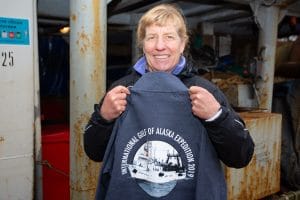
Laurie Weitkamp is a research scientist in NOAA Fisheries at the Hatfield Marine Station in Newport Oregon. She has a number of interests that include an international reputation for her work on the ocean ecology of Pacific salmon. Laurie recently contributed to both the Coho and Chinook salmon chapters in book published by the American Fisheries Society on the ocean life of Pacific salmon and trout. Laurie says that when Dick Beamish asked her if she would be interested in participating in an international expedition to sample salmon in the Gulf of Alaska in winter, she didn’t hesitate for a moment–“yes, that sounds really interesting!” was her immediate response. While there have been moments since then wondering what she had gotten herself into (the Gulf of Alaska in winter?!!!), she is still very enthusiastic about participating in the expedition for both personal and professional reasons. Laurie has also agreed to be a Chief Scientist and one of the expedition management team, along with Evgeny Pakhomov and Vladimir Radchenko.
On a personal level, she loves a good adventure and this expedition has all the makings to be exactly that, namely a lot of unknowns. She loves fishing with big trawls because you never know what you’re going to catch. The middle of the Gulf of Alaska is also uncharted territory for her, because all her ocean research has been within 40 miles of shore. She can’t wait to see what is caught, whether it’s large sharks or small squid, and will hopefully include a few rare fish only found far from land, such as king-of-the-salmon or lancet fish, which she always wanted to see in real life. Laurie is also intrigued to see what life is like on a Russian vessel, since her sea time has been limited to U.S. and Canadian commercial fishing boats and Federal ships. What will the food be like, do they play cards or watch movies when off watch, or how do the crew and scientists get along, are some of the many questions she asks. “I’ve also never been to sea for more than two weeks” she says, “so it will be interesting to see how I do for a whole month on what will undoubtedly seem like a very small ship at times”.
Laurie has seen a huge increase in the understanding of the marine ecology of Pacific salmon since she started her fisheries career in the early 1990s because of dedicated marine research programs around the North Pacific Rim. For example, there is now a fairly good understanding of where salmon go during their first and last summers in the ocean, what they eat in warm or cold years and the ocean conditions that promote or depress their survival. Despite this increase in knowledge, however, the winter period remains a “black box” because our ability to observe it directly is extremely difficult and expensive – it takes big ships to do the sampling and the weather can be horrible. While we can’t do anything about the weather, having the opportunity to be out there to observe salmon and their winter ecosystem is very exciting and should yield a wealth of information about salmon winter marine ecology. She is particularly excited to apply the advances in salmon genetics to marine collections, which now allows the determination of which river each fish came from, and in some cases which hatchery. We know that each stock of salmon does things a little differently in riverine, estuarine, and coastal waters, and Laurie predicts that each stock uses the high seas slightly differently as well, whether it’s where they’re distributed in the ocean or how large they are. Laurie says that the scientific crew assembled for this expedition is absolutely top notch; she really looks forward to getting to know her fellow scientists better and especially learning about their insight into salmon marine ecology, which isn’t easily conveyed in scientific papers or presentations. She hopes it will lead to future collaborations spanning the North Pacific. “While I know – and absolutely dread – that I’ll be sea sick at times, I’m really looking forward to the expedition and all the possibilities it presents; as a salmon marine ecologist, this is definitely a once in a lifetime opportunity! ”
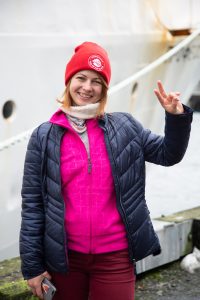
Anna Vazhova is a hydrochemist who graduated from the the Faculty of Chemistry in the Far Eastern State University (Vladivostok, Russia), where she studied from 2003 to 2008. She completed a postgraduate course in ecology and now is preparing a Ph.D. Candidate’s Thesis.
She has worked at TINRO in Vladvostok since 2009 where she participated in expeditions, including international surveys. As a researcher interested in Fishery Oceanography, Anna monitors chemical parameters in the coastal sea, rivers and lakes, mainly near the Japan Sea coast. She studies the causes of variability, including primary production, destruction of organic matter and anthropogenic pollution. Anna is interested in improved monitoring methods in physical oceanography, marine chemistry and biology.
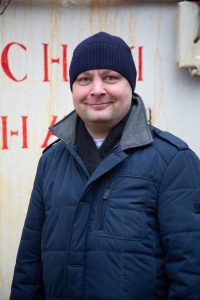
Mikhail Zuev has worked at TINRO since 2000 with a special focus on Cephalopods (Squids and Octopuses ). Mikhail studies the taxonomy, life cycle and fertility of squid in Okhotsk Sea, Bering Sea, Sea of Japan, and North Pacific. He also studies the general distribution of squids and octopuses in North Pacific including the commercial exploitation of armhook squid (Berryteuthis magister) and Japanese flying squid (Todarodes pacificus) in Russian waters. Squid are an important very poorly studied diet item of salmon in the Gulf of Alaska making squid studies an important part of Gulf of Alaska expedition. From the literature search, in the Gulf of Alaska, there are 15 species of squid from 4 families – Chiroteuthidae, Cranchiidae, Gonatidae, Onychoteuthidae. There is also a pelagic octopus Bolitaenidae. There are 9 species from the Gonatidae family including 5 species from Gonatus genus. He expects that the most abundant squid species during this survey will be Boreoteuthis borealis, Okutania anonycha, Berryteuthis magister. A first step of the squid study will include taxonomic identification, measuring size, weight, and biological condition on the research vessel. These data will provide geographical distribution of the species and the minimum and maximum abundances in the study area. Data on salmon feeding on the squid will be obtained (salmon diets) as well as squid diets. The second step of the study will depend on the abundance of squid, in accordance with the protocol that was prepared by Dr. Oleg Katugin. All further investigation of the samples will follow this protocol. Overall, the information will enable a better understanding of trophic relationships of squids and salmon in the Gulf of Alaska. After the expedition, Mikhail will use material collected from the squid samples (statolith and gladius) to improve the understanding of the squid life cycle, including ontogenetic stages. The DNA material collected will provide information on squid population structure. Hence, a big part of the squid study will be done in the lab at TINRO after the expedition. Mikhail says that “for me personally, the excitement of the expedition is discovering a new geographic region where squid play an important role in marine ecosystems, the possibility of publications, acquaintances with international colleagues, and building professional relationships for future research.”
Vessel Route
We receive the vessel’s coordinates daily. This map shows the vessel’s progress to date.
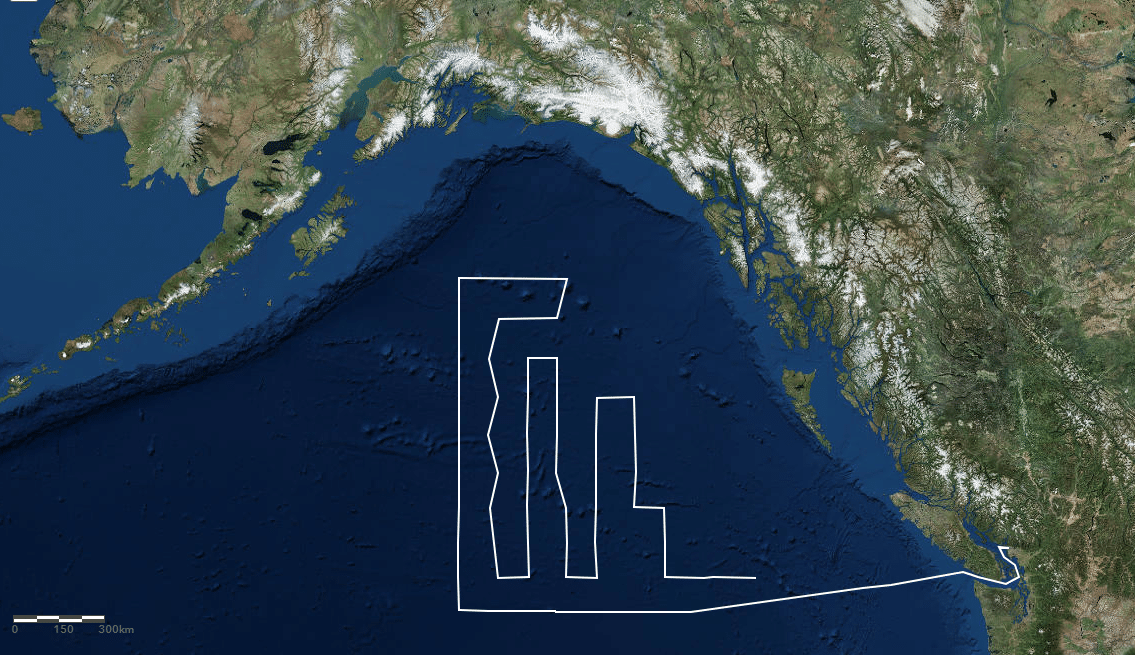
Scientific Equipment in Use
Description: A midwater trawl is a very large funnel-shaped fishing net. The front of a midwater trawl is generally constructed from large hexagonal or rhombic mesh or near-parallel ropes. Trawling involves the towing of net behind the fishing vessel. Large trawl doors that are essentially “kites” pull the net open sideways (50m) and the mouth of the net 50m is held open vertically by floats on the top and a weighted lead line on the bottom. The net is towed at 2.5-3 knots and the fish are swept back in the narrow end of the net called the codend. It takes consider able power to fly the net with the headrope at the surface to catch salmon that tend to live in the top 50m.
This is a large box which can hold up to 1,000 liters of water will be used to keep live salmon (up to 70 cm) for further sampling. The box is inserted in the narrow portion of the midwater trawl and the fish are always in water as the net is brought back on board the ship. In the absence of this box the fish in the net are not in good enough condition to tag and release back into the ocean.
A bongo net consists of two plankton nets mounted next to each other. The nets have a long funnel shape with a small mesh width (0.2336mm) used for collecting plankton. The bongo net can be configured to be towed vertically (up and down) or horizontally towed at 1-2 knots with a weight attached between the nets.
A plankton Juday net is a mesh net with a cone-like end that is towed vertically through the water column. The Juday net allows for the sampling of zooplankton within different vertical water layers and is often used at different periods of the day (light and darkness).
A type of net that is towed behind the vessel with a mesh size small enough (300 um) to collect microplastic. With this equipment, the scientist will be able o sample a layer of approximately 20cm at the water surface, where low density microplastics accumulates.
CTD stands for conductivity, temperature, and depth and the device’s function is to detect how conductivity and temperature of the water column changes relative to depth. Conductivity is a measure of how well a solution conducts electricity, and it is directly related to salinity, or the concentration of salt and inorganic compounds in seawater. CTDs are attached to a metal frame called a rosette, which holds water-sampling bottles that collects seawater at different depth. The information that is generated from CTD data can be used to calculate the speed and direction of ocean current as well as map the distribution of temperature and salinity throughout a survey area spatially as well as at depth.
This technology allows scientists for the first time to sequence the DNA of salmon actually on the vessel and determine what stock it originated from. In the future surveys could use this tool to study the finer scale distribution of stocks at sea.
Updates and News from the Vessel
NPAFC Announces Expedition Departure
The North Pacific Anadromous Fish Commission (NPAFC) announced that the International Gulf of Alaska Expedition 2019 is underway with 21 scientific personnel from five Pacific Rim countries, Japan, Korea, Russia, the United States and Canada departing this afternoon aboard the chartered 62m Russian Research Vessel “Professor Kaganovskiy.
Watch the most recent video from the Expedition!
In the News
International salmon research expedition departs for Gulf of Alaska
The Secret Lives of Salmon: Scientists run test fishery before heading to open ocean
The secret lives of salmon: B.C.-led international expedition to probe ailing Pacific stocks
Scientists seek out the secret of salmon during ocean voyage
“Knowing the origin of the fish is critical in research designed to understand what is regulating survival and variability between stocks. DNA stock analysis is now a common tool used in both fisheries in season management and in fisheries science.” Click here for more!
“Because so little salmon research has been conducted in this area at this time of year, our collective results fill an important gap in our knowledge of the salmon life cycle.” Click here for more!
“The expected and surprising observations run across all aspects of the ecosystem we are studying, from water chemistry to plankton to fish. Here are a few of the highlights.” Click for more!
“One thing that really surprised both Aleksei and Chrys was how many coho salmon we’re catching in the Eastern Pacific.” Click here for more!
“How well Chinook and other Pacific salmon can adapt to such rapid changes is not known. However, by understanding the factors that regulate the survival we will be better informed to be able to successfully manage and sustain this species for years to come.” Click here for more!


